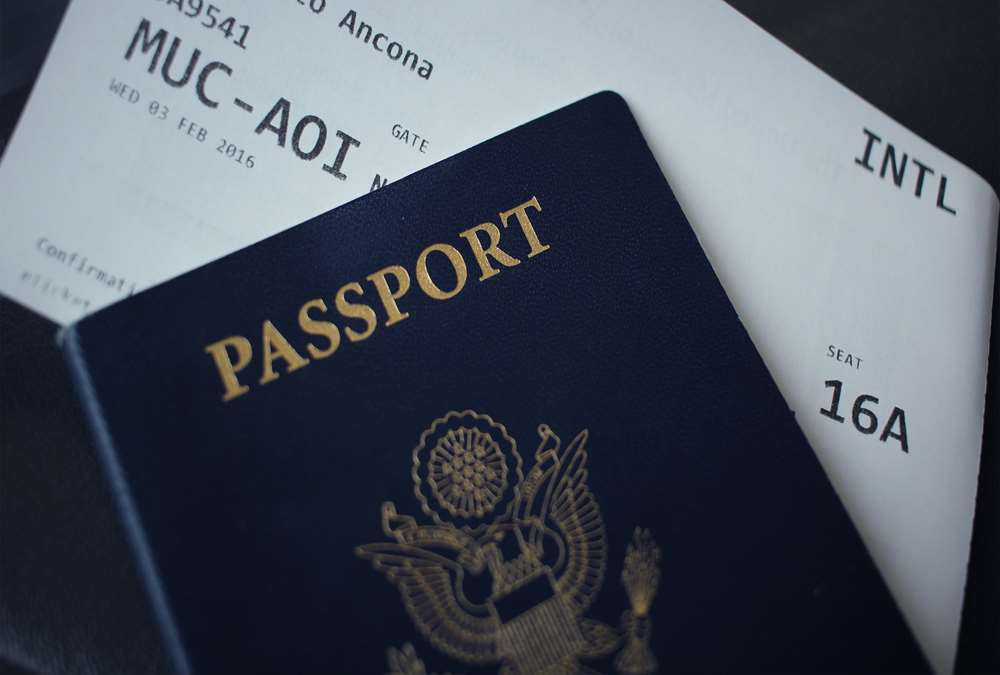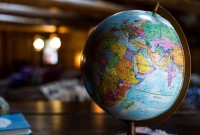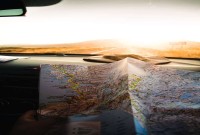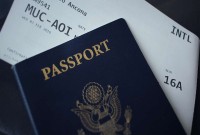- Home
- Business Processes
- Industry Knowledge
- Aerospace Industry
- Automotive Industry
- Banking Domain
- BFSI Industry
- Consumer/ FMCG Industry
- Chemicals Industry
- Engineering & Construction
- Energy Industry
- Education Domain
- Finance Domain
- Hospitality Domain
- Healthcare Industry
- Insurance Domain
- Retail Industry
- Travel and Tourism Domain
- Telecom Industry
- Leadership Skills
- eLearning
- Home
- Industry Knowledge
- Travel and Tourism Domain
- Types of Tourists
Types of Tourists
Wealthy people have always traveled to distant parts of the world, to see great buildings, works of art, learn new languages, and experience new cultures, and to taste different cuisines. There has been an up-trend in tourism over the last few decades and now national or international travel for short breaks is very common. Tourists have a wide range of budgets and tastes, and a wide variety of resorts and hotels have been developed to cater for them.
While all-embracing definitions of tourism and the tourist are desirable; in practice, tourists represent a heterogeneous, not a homogeneous, group with different personalities, demographics, and experiences. We can classify tourists in four basic ways which relate to the nature of their trip:
Domestic & International Tourists
A basic distinction can be made between domestic and international tourists, although this distinction is blurring in many parts of the world (for example, in the European Union). Domestic tourism refers to travel by residents within their country of residence. There are rarely currency, language, or visa implications, and domestic tourism is more difficult to measure than international tourism. As a consequence, domestic tourism has received little attention. In contrast, international tourism involves travel outside the country of residence and there may well be a currency, language, and visa implications.
Based on Travel Arrangements
The type of travel arrangements purchased, such as:
- An inclusive tour where two or more components of the trip are purchased together and one price is paid;
- Independent travel arrangements where the traveler purchases the various elements of the trip separately
- Tailor-made travel, which is a combination of the two and increasingly common due to the use of the Internet to purchase travel
- Distance traveled, which is used to make the distinction between long-haul tourism (generally taken to mean travel over a distance of at least 3000 kilometers), and short-haul or medium-haul tourism (involving shorter journeys). This is important in terms of marketing and aircraft operations (and has implications for carbon emissions)
Purpose of Visit
Tourists can also be classified by the ‘purpose of visit category’. Not only are these categories used for statistical purposes, but they are also useful for the marketing of tourism. The terms tourism and travel are generally used interchangeably. However travel has a similar definition to tourism, but implies a more purposeful journey. So the travel could be done for leisure or to accomplish any specific purpose like IT professional travelling onsite to meet customer on his project. Hence “Tourists” can be classified conventionally into the following three categories:
1. Leisure and recreation
This includes holidays, sports and cultural tourism, and visiting friends and relatives. These people travel for pleasure. Lately the leisure tourism has emerged strongly owing to changes in lifestyle; consumption pattern of people, growing leisure needs to de stress and rejuvenates. Leisure travel may be done for holidays, sports, education projects, school trips, family outings, weekend gateways etc.
2. Other tourism purposes
This includes the study and health tourism. While the tourist visa will not allow the holder to join a course of study, the holder of a student visa can travel the country and enjoy the sightseeing and meeting. Educational tourism is developed because of the growing popularity of teaching and learning of knowledge and the enhancing of technical competency outside of the classroom environment. In educational tourism, the main focus of the tour or leisure activity includes visiting another country to learn about the culture, study tours, or to work and apply skills learned inside the classroom in a different environment, such as in the International Practicum Training Program. Health tourism is a wider term for travel that focuses on medical treatments and the use of healthcare services. It covers a wide field of health-oriented tourism ranging from preventive and health-conductive treatment to rehabilitation and curative forms of travel. Wellness tourism is a related field.
3. Business and professional
This includes meetings, conferences, missions, incentives, and business tourism. These people travel to meet their work-related needs like to attend business conventions, meetings, conferences or to meet any purpose which is incidental to the work requirements. Business tourism involves traveling to a destination away from home or a normal workplace. It is a type of travel for professional purposes rather than personal. Some types of business tourism are incentive travel, exhibitions & trade fairs, conferences & meetings, and corporate events.
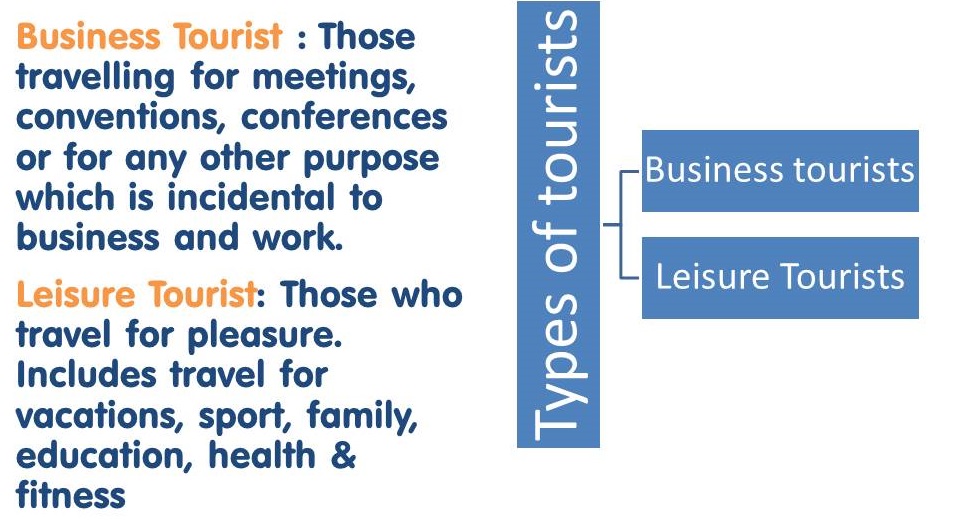
There are many other ways to classify tourists. These range from simple demographic and trip classifications, through to their lifestyles and personalities, to their perception of risk and familiarity and postmodern interpretations of consumers and commodities. However, one approach with increasing relevance to contemporary tourism is to classify tourists according to their level and type of interaction with the destination. We can also distinguish many types of tourism as heritage, cultural, urban, rural, eco- and nature-based tourism.
Related Links
You May Also Like
-
Economic Impact of Tourism Industry
The tourism industry has contributed to the economic growth of a country through factors like industrialization, education, advanced technology, a higher number of qualified professionals, opening up of foreign markets, liberal trade policies, and better advertising and strategic marketing. The income generated helps the national balance of payments, earning revenue through direct taxation, as well as from indirect taxes on goods and services purchased by the tourists.
-
How does Tourism Industry impact a country? The impact of the tourism industry can be classified into the social & cultural impact, economic impact, and environmental impact. Social & cultural impact signifies the impact which it creates in terms of social changes. The economic impact can be quantified in terms of monetary benefits and overall economic development of the society. Environmental impact refers to the impact on nature and the surrounding areas.
-
Overview of Hospitality Industry
Hospitality is the act of kindness in welcoming and looking after the basic needs of customers. The hospitality industry is a broad group of businesses that provide services to customers. The industry can be broken down into three basic areas: accommodations, food and beverage, and travel and tourism. Hospitality is actually one facet of the service industry. It primarily involves addressing customer satisfaction and catering to the needs of guests.
-
Challenges in the Tourism Industry
Top challenges confronting tourism are taxation, travel marketing, infrastructure issues, and security and cross border regulations. Too many tourism destinations are not prepared for visitors. Tourists or travelers can at times deem travel marketing to be exaggerated. Another major challenge that the tourism industry faces is the fluctuating rates and cost inflation. New challenges seem to arise quickly impacting the industry as a whole.
-
We all travel and have been a tourist, perhaps many times in our life. Tourism and tourist are so common words that they find mention in newspapers and magazines almost on a daily basis. In spite of its popularity, have you ever deliberated what the definition of travel and tourism is? What components constitute the tourism industry? Who qualifies to be called a tourist? Well, this article attempts to explore the words "travel”, “tourism” and "tourist'- both technically as well as conceptually.
-
Social & Cultural Impact of Tourism
Tourism may have different effects on the social and cultural aspects of life in a particular region depending on the strengths of the region. The effect can be positive or negative. Tours also focus on unique natural or geographical features like the coastline, islands, mountains, health resorts, countryside, etc. At such locations, the provision of tourist services and the pressure of tourists are bound to have impacts on the environment, economy, and local social practices and on the people.
-
Environmental Impact of Tourism Industry
The environment is the surrounding atmosphere or condition for existence. The impact of tourism on the environment is both positive and negative. This article considers the major issue of the consequences of tourism for the environment. This is a complex area as, whilst tourism is dependent upon environmental quality to attract and support visitors, it also can have a detrimental effect upon those very environments – and their climate.
-
Wealthy people have always traveled to distant parts of the world, to see great buildings, works of art, learn new languages, and experience new cultures, and to taste different cuisines. There has been an up-trend in tourism over the last few decades and now national or international travel for short breaks is very common. Tourists have a wide range of budgets and tastes, and a wide variety of resorts and hotels have been developed to cater for them.
-
Components of Tourism Industry
The tourism sector is a range of businesses and organizations involved in delivering the tourism product. All the elements of tourism are related and interact; in essence, the tourism industry is a system of customers and suppliers who demand and supply tourism products and services. In relation to tourism, very often you will come across terms like tourism products and services. These components of travel and tourism can be broadly divided into six key areas highlighted below.
Explore Our Free Training Articles or
Sign Up to Start With Our eLearning Courses

About Us
Learning
© 2023 TechnoFunc, All Rights Reserved
